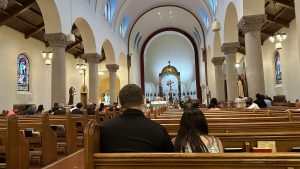“Te alabamos senior” is the Spanish language translation of the phrase “thanks be to God.” The growing number of Spanish speaking parishioners of Immaculate Conception Church in Clarksburg have even more reason to be thankful to God as the church finds new ways to serve its congregants.
As Mass opens at 9:15, one immediately sees the warm and joyful environment. The majesty and beauty of the church itself with its high vaulted ceilings and Corinthian columns, flanked by the writers of the Gospels and Old Testament prophets in ornate stained glass, is well complemented by the sounds of delighted children.
Of perhaps the 60 attending on a recent Sunday, at least two dozen were children, some of toddler age.
Kevin and Alma Tyson explained the difference with other churches in the inclusion of all children. As Alma explained, their Masses include “a lot of kids. In our culture, we bring the kids so they can love the Church and the Mass.”
“They’re comfortable in the sanctuary,” Kevin added, adding that it helps children to get used to making church services a part of family life.
As the services continue, the rituals of Mess are punctuated by angelic singing and acoustical music. Those present take great pride and joy in participation in church, but also in building a community.
Latin American and Spanish speaking communities take great pride in their Roman Catholic faith and membership in the Church is respected by the community. “In a Hispanic country,” Kevin explains, life “revolves around the Church.”
Monsignor Paul Hudock adds that such a community commitment is “a blessing for me as a priest. They love their Christian faith. They want to go to church. I’m doing this because they want the Sacraments. They want the Church experience.”
Connie Wolfinger, who has served as a driving force for more Spanish language inclusion, explained that Immaculate Conception has held Spanish Masses for a decade. Originally, local Spanish speakers had attended Masses in English. She stated that the “asked some of us who were bilingual to speak with Father Casey about having masses in Spanish. The Mexican community enjoyed having the Mass in their language as most are not bilingual, they liked that they could understand the priest.”
They started with one per month. A changeover in priests led to a doubling of that frequency. Monsignor Hudock now leads them every week. Wolfsinger said that “the members can participate in the mass as lectors, Eucharistic Ministers, and a cantor who sings in Spanish and plays a guitar.”
Two missionaries help the monsignor to conduct services while helping to serve the congregation. Rosalie Hernandez, originally from New York, moved first to Indiana at the age of four, then to West Virginia four years later. Hernandez says that the Mountain State is “where I have been living for the past 13 years. Therefore I feel more West Virginian than a New Yorker!”
Heydie Perez came from Oaxaca, a state on the southwest Pacific Coast of Mexico, but has lived in Columbus, Ohio for the past six years.
The missionaries arrived three weeks ago and have served the community from both Immaculate Conception and also St. Mary’s in Morgantown. They also work in Georgia and Ohio as well.
Hernandez shared that when she was 14 she encountered a group of missionaries at her church, remembering that “I saw the work they did in spreading the gospel through retreats and different activities for youth, and how they traveled to different parts of the country. But most of all i saw their joy while doing it. Right there I knew I wanted to be missionary someday once I got older.”
Perez also was inspired by the example of the service of others. She explained that “I encountered a group of young men in my church that were joyful and very helpful to the people. Something in them made me question the reason of why they were doing this type of work (without receiving no pay) but I knew that whatever it was I myself wanted it to.”
Both not only assist with the Mass and other functions, but, as Wolfsinger says, also are coming up with more outreach ideas.
After the Mass, participants gather in the dining area behind the church. Members bring traditional and other foods for a potluck lunch. The magnificent aromas of tamales, rice dishes, and other favorites fill the air as congregants meet, greet, and eat.
In addition to worshiping God, the Masses help to bring newcomers to the nation and the area together. Immigrants have come from chiefly Mexico in the past, but now more arrive from Central America. “I’m impressed by their families,” said Hudock, who added that “these men and women work hard. They’ve given up a lot to be here from a different culture.” Many families have signed their children up at both St. Mary’s and Notre Dame to attend school.
The Church provides a venue, much like it did for Italians a century and more ago, to support each other. Monsignor Hudock, who has ministered in the area for a year and a half, says that “it obviously fits a pattern of a history of immigrants in Clarksburg.”
For its Spanish speaking congregants, Immaculate Conception Church will continue to serve as a rock on which to worship in their faith and gather together their community..


